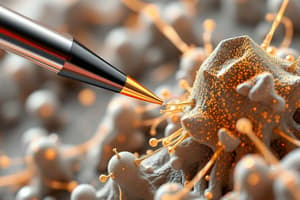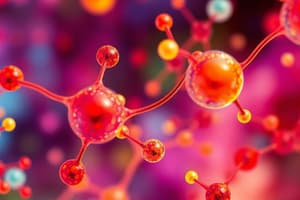Podcast
Questions and Answers
What is AFM short for?
What is AFM short for?
Atomic force microscopy
What is the resolution of AFM compared to the optical diffraction limit?
What is the resolution of AFM compared to the optical diffraction limit?
More than 1000 times better
How does AFM gather information about the surface?
How does AFM gather information about the surface?
By 'feeling' or 'touching' with a mechanical probe
What are the three major abilities of AFM?
What are the three major abilities of AFM?
What enables precise scanning in AFM?
What enables precise scanning in AFM?
What type of microscopy is Atomic Force Microscopy (AFM)?
What type of microscopy is Atomic Force Microscopy (AFM)?
What facilitates precise scanning in Atomic Force Microscopy (AFM)?
What facilitates precise scanning in Atomic Force Microscopy (AFM)?
What is one of the major abilities of Atomic Force Microscopy (AFM)?
What is one of the major abilities of Atomic Force Microscopy (AFM)?
What is the demonstrated resolution of Atomic Force Microscopy (AFM) compared to the optical diffraction limit?
What is the demonstrated resolution of Atomic Force Microscopy (AFM) compared to the optical diffraction limit?
What is used to gather information in Atomic Force Microscopy (AFM)?
What is used to gather information in Atomic Force Microscopy (AFM)?
Flashcards
AFM short for?
AFM short for?
Atomic force microscopy
AFM resolution compared to optical?
AFM resolution compared to optical?
More than 1000 times better
AFM information gathering method?
AFM information gathering method?
Using a mechanical probe to 'feel' or 'touch' the surface.
AFM major abilities (3)?
AFM major abilities (3)?
Signup and view all the flashcards
Precise AFM scanning?
Precise AFM scanning?
Signup and view all the flashcards
AFM type of microscopy?
AFM type of microscopy?
Signup and view all the flashcards
AFM precise scanning tool?
AFM precise scanning tool?
Signup and view all the flashcards
One AFM major ability?
One AFM major ability?
Signup and view all the flashcards
AFM resolution compared to optical diffraction?
AFM resolution compared to optical diffraction?
Signup and view all the flashcards
AFM information tool?
AFM information tool?
Signup and view all the flashcards
Study Notes
Atomic Force Microscopy (AFM) Overview
- AFM stands for Atomic Force Microscopy.
- It is a type of scanning probe microscopy.
Resolution
- AFM has higher resolution compared to the optical diffraction limit, achieving resolutions in the nanometer range.
- Optical diffraction limit is generally about 200 nm, while AFM can achieve sub-nanometer resolution.
Data Gathering
- AFM gathers information about surfaces by scanning a sharp tip attached to a cantilever over the surface.
- The interactions between the tip and the surface cause cantilever deflection, which is measured to create topographical maps.
Major Abilities
- Three major capabilities of AFM include:
- High-resolution imaging of surfaces at the atomic level.
- Measurement of surface forces and mechanical properties.
- Ability to manipulate materials at the nanoscale.
Scanning Mechanism
- Precise scanning in AFM is enabled through a flexible cantilever that detects minute changes in force.
- The piezoelectric actuators control the position of the cantilever with high accuracy.
Information Gathering
- A sharp tip is used to sense and image surface features via van der Waals forces and other short-range interactions.
- This contact or non-contact mode allows for comprehensive analysis of sample surfaces.
Key Feature
- One of the major abilities of AFM is obtaining three-dimensional topographical images of surfaces, providing detailed insights into surface structure and morphology.
Studying That Suits You
Use AI to generate personalized quizzes and flashcards to suit your learning preferences.




